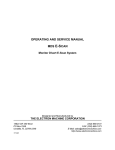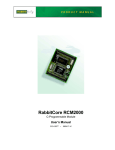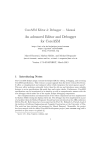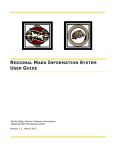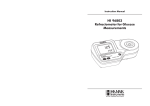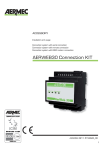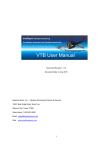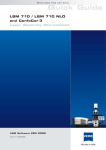Download Electron Machine Corporation MPR E
Transcript
OPERATING AND SERVICE MANUAL MPR E-S CAN Microprocessor Refractometer with Color Display Designed and Manufactured by THE ELECTRON MACHINE CORPORATION 15824 CR 450 West Post Office Box 2349 Umatilla, FL 32784-2349 110525 (352)-669-3101 FAX: (352)-669-1373 E-Mail: [email protected] http://www.electronmachine.com MPR E-SCAN INTRODUCTION Introduction The Electron Machine Corporation MPR E-SCAN The E-Scan is a microprocessor driven critical angle refractometer. It is used to measure the refractive index of process fluids which directly correlate with customer request for dissolved solids, Brix or other meaningful measurement. The E-Scan may be used as an error indicator or an integral part of a complete process control system. The E-Scan is equipped with a broad range of diagnostics to aid in fault isolation without the use of special test equipment. The instrument is calibrated before leaving the factory and should not need recalibration unless some modification is made to the sensing head. Calibration procedures are available to change system parameters and allow the refractometer to measure different process fluids. Extensive literature is available for various industries listing the correlation between refractive index, degrees Brix, or % solids and specific process parameters. The E-Scan consists of: • • • Sensing head Console Interconnecting cable MPR E-Scan Overview 1 MPR E-SCAN INTRODUCTION Important Manual Information The Chapter title is at the top of each page for quick reference through the manual. Important points, reminders, and warning messages are printed in bordered boxes as: NOTE: Box indicates important messages. This is a general use manual. In the back of the manual are addendums and configuration information specific to the individual unit. CAUTION When removing the sensing head from an operating line, do not assume that the line is empty or that the isolation or bypass means is working properly. If an EMC isolation valve is used, be sure its travel is not limited by any external attachments or other interference and the valve is closed tightly. No pressure should be felt on the head as the mounting nut is being removed. ANY PRESSURE FELT WHEN THE NUT IS LOOSENED MUST BE INVESTIGATED BEFORE PROCEEDING. Steam should be turned off before attempting to remove the head. Use a face shield and protective clothing. Stand to the side when removing the sensing head. Clean all black liquor residue from spud-piece on adapter prior to re- insertion of sensing head. The o-ring seal should be replaced before re- installation. 2 Table of Contents 1. Installation............................................................................................................... 1 - 1 1.1 Site Selection..............................................................................................1 - 1 1.2 Power Requirements...................................................................................1 - 1 1.3 Attaching the Sensing Head .......................................................................1 - 1 1.4 Steam Purge Attachment ............................................................................1 - 2 1.5 Interconnection...........................................................................................1 - 3 1.5.1 Analog Outputs............................................................................... 1 - 3 1.5.2 Printer Output .................................................................................1 - 4 1.6 Prism Clean ................................................................................................1 - 4 1.6.1 Steam Pressure................................................................................1 - 4 1.7 Start-Up ......................................................................................................1 - 4 2. Operation................................................................................................................. 2 - 1 2.1 The Operator's Panel...................................................................................2 - 1 2.1.1 Display............................................................................................ 2 - 1 2.1.2 Button Touch Pad Function Chart ..................................................2 - 2 2.1.3 Measurement Signal Graphing for the MPR E-Scan .....................2 - 3 2.2 Normal Mode..............................................................................................2 - 4 2.2.1 What Normal Mode Does................................................................2 - 4 2.2.2 System Indicators ...........................................................................2 - 4 2.2.3 The Menu Options in Normal Mode ..............................................2 - 5 2.2.4 Overview of Menu Options ............................................................2 - 6 2.3 Product Selection........................................................................................2 - 7 2.4 Calibration Selection................................................................................2 - 10 2.5 Configuration Selection............................................................................2 - 15 2.6 Print Selection ..........................................................................................2 - 20 2.7 Diagnostic Selection.................................................................................2 - 21 2.8 Offset Selection........................................................................................2 - 24 2.9 Purge Selection.........................................................................................2 - 25 2.10 Hold Selection..........................................................................................2 - 26 3. Problem Analysis .................................................................................................... 3 - 1 3.1 Procedures ..................................................................................................3 - 1 3.2 Trouble Shooting Chart ..............................................................................3 - 2 4. Service..................................................................................................................... 4 - 1 4.1 EMC Warranty ...........................................................................................4 - 1 4.2 Return of Defective Parts ...........................................................................4 - 1 4.3 Service in the Field .....................................................................................4 - 1 4.4 Spare Parts ..................................................................................................4 - 2 4.4.1 How to Order Parts .........................................................................4 - 2 4.4.2 Available Spare Parts .......................................................................4 - 2 4.5 Preventive Maintenance .............................................................................4 - 3 4.6 Caution .......................................................................................................4 - 3 4.7 Maintenance Log Sheet ..............................................................................4 - 4 5. System Information................................................................................................. 5 - 1 5.1 Technical Description................................................................................5 - 1 5.1.1 Sensing Head ................................................................................5 - 1 5.1.1.1 Optics ........................................................................... 5 - 1 5.1.1.2 CCD Linear Array.......................................................... 5 - 2 5.1.1.3 Signal ............................................................................. 5 - 2 5.1.2 Console ..........................................................................................5 - 3 5.1.2.1 Display........................................................................... 5 - 3 5.1.2.2 Switch Matrix................................................................. 5 - 3 5.1.2.3 Cable entry and mounting .............................................. 5 - 4 5.1.2.4 IB (interface board) for external connection................. 5 - 4 5.1.2.5 Power supply.................................................................. 5 - 4 5.1.2.6 I/O card .......................................................................... 5 - 4 5.1.2.7 CPU Card ....................................................................... 5 - 5 5.1.2.8 Supplemental Card Information..................................... 5 - 6 5.2 Refr actometer Specifications ......................................................................5 - 7 5.3 Available Options .......................................................................................5 - 7 6. Drawings List .......................................................................................................... 6 - 1 MPR E-SCAN 1. Installation 1.1 Site Selection INSTALLATION The E-Scan console can be mounted in any area where ambient conditions allow personnel to remain for extended periods. The cabinet is Nema 4X rated and should be kept closed. MPR E-Scan Instrument 1.2 Power Requirements The A.C. power should be supplied from a line which is not subjected to power interruptions or heavy inductive loads. A.C. power can be 120/220 VAC at 50 or 60 Hertz. 1.3 Attaching the Sensing Head Care must be taken not to damage the thermistor probe protruding from the sensing head on units so equipped. The sensing head as received will have a protective sleeve around the probe area. To facilitate fast thermal response the tip and walls of the probe are very thin making it somewhat fragile. The sensing head is attached to the process line by an adapter which can be carbon steel, stainless steel (316) or a material specified by the customer. This adapter must not be placed in an area where vibration is severe or excessive. Sensing Head to Adapter Positioning. The adapter should be oriented to place the head in a horizontal plane to assure that deposit buildup and air pocket creation will be minimal. If the sensing head is to be mounted on a vertical pipe, the fluid flow should be upward. The arrow on the adapter should point in the direction of fluid flow. (See Head to Adapter Positioning.) 1-1 MPR E-SCAN INSTALLATION The probe end of the sensing head has a groove for an interface o-ring. This o-ring must be in place prior to installing the head into the adapter to prevent the process leaking out. The head is attached to the adapter by a 2- inch sanitary nut. The nut should be tightened with a wrench (supplied by EMC) to a maximum 50 foot pounds of torque (68 Newton-Meter). Alignment marks are provided for units utilizing a steam purge cleaning cycle to ensure that the thermistor probe will not be in a direct line of the steam blast. (See drawing below.) The sensing head houses optical components which are susceptible to the effects of moisture. The cover is moisture proof and contains a small amount of desiccant to absorb any moisture remaining in the head after assembly. The sight glass on the head allows inspection of the desiccant. Light orange indicates that it remains effective. Clear indicates it is no longer effective and must be changed. The desiccant can be renewed by heating to approximately 250° F (121° C) until it recovers its orange color. 1.4 Steam Purge Attachment Steam Purge Attachment - for liquids which exhibit a tendency to "coat" The steam purge valve must be similarly mounted to the adapter with a minimum of 6" and a maximum of 18" from the steam port on an adapter preferably with 1/4" tubing. It is essential that NO LEAKS be present in this line that could allow evaporation of liquids, thereby plugging the purge line . Steam pressure must be at least 50 psi (3.44 bar) above process pressure but less than 100 psi (6.89 bar) above process pressure with adequate condensate drainage at the steam valve in order to ensure hot steam for cleaning the prism. Trial and error must, of necessity, be employed in determining the minimum steam time necessary for proper steam cleaning of the prism due to variables from application to application. Steam purge time must be kept at a minimum typically from 1 to 10 seconds duration, to avoid excessive prism deterioration, while at the same time keeping the intervals between these purge times at maximum, which may vary from minutes to many hours. 1-2 MPR E-SCAN 1.5 INSTALLATION Interconnection The E-Scan offers many options for external device connections. 1.5.1 Analog Outputs In addition to voltage outputs, the EScan also offers current outputs for the measurement and also the temperature. The measurement is a standard output and temperature is an option. Output for these readings is a 4 to 20 mA signal that is referenced to ground (non- isolated) so that any device that is connected to these outputs must have a floating (or isolated) input. Isolated current output modules are available as an option. The output for the measurement reading is found on TB 3 terminals 1 and 2. Terminal 1 is the positive output for both the isolated output option and the standard non isolated output module. The output for the temperature is located on TB 3 terminals 3 and 4, 3 being the positive output in this case. The modules on the top of the interface board represent the output modules. The one on the left U1 is the output module for the measurement. U2 is the output module for the temperature. The other modules (U3 and U4) are for optional features and are explained in the optional addendums to this manual. It is an easy process to change from a non- isolated module to an isolated output module. You must first remove the power supply, then unplug the non- isolated module and replace it with the isolated module. The isolated modules are blue potted modules while the non- isolated modules are bare board modules. If a 0-10 voltage output is desired then TB 4 terminal 1 is the measurement output and terminal 2 is the temperature output. Terminal 3 is the common for both of these outputs. The cable should not be placed in a tray or conduit with wires attached to heavy inductive loads or SCR drives. A separate conduit is recommended. 1-3 MPR E-SCAN INSTALLATION 1.5.2 Printer Output The E-Scan offers a printer output as an option via CPU card parallel port J17. The connector is easily installed either in the field or at the time the instrument is manufactured. The standard printer output is via the Com/LPT card. Please refer to interconnection drawing for the Com/LPT Card for the proper connection of a printer to the E-Scan. The printer output should be used for short runs only, less than 50 feet (15.2 meters). If a longer cable is desired then a printer buffer should be used to extend the cable length. 1.6 Prism Clean The following refers to steam, however, other mediums may be used as the prism cleaning agent: The E-Scan provides two normally open contacts for prism clean. These contacts are intended to directly operate the steam (TB2-11,12) and condensate drain (TB2-9,10) valves. Electrical interconnection for these devices is also shown in the interconnection drawing. These contacts are dry contacts and power must be supplied from an external source as shown on the drawing. 1.6.1 Steam Pressure The steam pressure must be no less than 50 psi (3.44 bar) and no greater than 100 psi (6.89 bar) above the process line pressure. Both the steam and condensate drain valves should be located as close to the steam purge fitting as possible. The condensate drain valve is provided to remove water from the steam line to allow free passage of steam to the head. See also Steam Purge Attachment in Installation Section. 1.7 Start-Up Turn power on. Allow sufficient time for the sensing head to stabilize at the process temperature. It is recommended that no adjustments be made for at least 15 minutes after startup. Compare the reading against a sample taken from the process line close to where the unit is installed and at the process operating temperature. If the sample does not equal the displayed reading, adjust the analog zero per Operation/Calibration section. Important: Prior to shipment the sensing head is matched to the console and factory calibrated. DO NOT ATTEMPT TO RE-CALIBRATE 1-4 MPR E-SCAN 2. OPERATION Operation This equipment is designed for continuous operation and may be left on for extended periods of time. 2.1 The Operator's Panel The Operator’s Panel or Front Panel consists of a display and a 20-button touc h pad which form the interface between the operator and the instrument. The display consists of a 640 x 480 pixel TFT LCD screen which provides the operator with various messages. The 20 button touch pad allows the operator to make entries and instigate commands. 2.1.1 Display The three basic types of messages displayed are: Variable : These information lines contain either set points that may be altered by the operator, or measurement variables that are updated by the CPU. Alternate Action: Acts much like a two position switch and is used to select various menu options. The operator is able to alternate between two states, such as ON and OFF. Error Display: Flashes continuously to attract operator’s attention to an error condition. 2-1 MPR E-SCAN OPERATION 2.1.2 Button Touch Pad Function Chart Scrolls cursor horizontally to the left and also used to initiate editing of calibration voltages in the calibration table, and temperature values in the compensation table. Scrolls cursor horizontally to the right and also used to initiate editing of all system parameters excluding those accessed by the LEFT ARROW. Scrolls cursor vertically in the “Up” direction. Scrolls cursor vertically in the “Down” direction. ENTER Used to select all cursor items and to save edited data. Esc Used to abort to previous operation without saving edited data. Menu Used to immediately display the normal mode of operation without saving information or main menu selections if already in normal mode. PgUp Displays previous screen of information or mode of operation when indicated on the screen. Used to exit graph mode and return to normal mode. PgDn Displays the next screen of information or mode of operation when indicated on the screen. Used to enter graph mode from normal mode. +/- Allows data fields to be either positive or negative. Toggles configuration and diagnostic options as well as control modes, if configured for P.I.D. control. Also used to record sample readings used for analog zero adjustment. 0-9 Numeric keys used to input data. 2-2 MPR E-SCAN OPERATION 2.1.3 Measurement Signal Graphing for the MPR E-Scan Graph Mode Screen The MPR E-Scan offers a graphical mode display which can be accessed from the normal mode of operation via the PgDn button on the front panel switch matrix. PgUp will then return to the normal mode display. The graphical mode display comes equipped with all the essential information including the current product, error status, and measurement reading, in addition to the graph span and time. The graph span limits are derived from the analog low and high limits in calibration and are drawn on the display at the top and bottom of the graph area as dotted lines. The graph time can range from 5 minutes to 9999 minutes and can be accessed via the button on the front panel switch matrix. The calibration alarm limits are also displayed graphically within the graph area and are drawn as red dashed lines to differentiate them from the graph span limits. The alarm limit lines are drawn 20 pixels apart horizontally, which gives the added feature of breaking the graph time into 20 equal parts. Thus, if the graph time were 20 hours, each alarm limit segment would represent 1 hour. Finally, the measurement signal itself is drawn in the graph area and can be recognized as a single continuous stream of information that is 2 pixels thick. The measurement graph offers a high quality display with 574 pixels of horizontal and 295 pixels of vertical resolution. 2-3 MPR E-SCAN 2.2 OPERATION Normal Mode 2.2.1 What Normal Mode Does In normal mode the system displays the following information: • • • • • • • • • Name of the current product being measured along with an associated product number. Software version number. Current time and date. On-line measurement such as BRIX, SOLIDS.... On-line temperature in Degrees Fahrenheit and Centigrade. Alarm points for measurement and temperature. Error status for system measurement, temperature and voltage levels. Graphics menu to allow access to other MPR E-Scan system features. Purge information when configured for purge operation. Note: In normal mode set points cannot be changed or adjustment s made. 2.2.2 System Indicators C Isolation valve is closed. The MPR E-Scan will not initiate a prism clean. T Below min purge temperature limit. No prism clean allowed. H Measurement Hold. Current readings and analog outputs are maintained until complete. Can be invoked by menu selection in normal mode or by external input if configured for on demand hold. Measurement Hold can also indicate a cleaning cycle in progress which is indicated by a purge message as well as a current measurement voltage display while in normal mode. P Purge failed. This means the previous purge cycle did not properly clean the prism. This indicator is used only when smart prism cleaning is configured. O Measurement over range. Current reading above last calibration point for MPR E-Scan in the calibration table. U Measurement under range. Current reading below first calibration point for MPR E-Scan in the calibration table. S Measurement sample reading has been recorded as the reference for analog zero adjustment. 2-4 MPR E-SCAN OPERATION 2.2.3 The Menu Options in Normal Mode Normal mode is entered by default, upon power up. To gain access to other system features select the MENU button on the Front Panel To uch Pad. Note: The screen names and setpoints below are just an example, they will vary from application to application. Normal Mode Screen With Menu Options When the MENU button is selected, the following menu options are displayed on the normal mode screen: Normal Mode Screen With Purge and Hold Options If “Purge” and “Hold” options are configured, the following menu options are displayed on the normal mode screen: 2-5 MPR E-SCAN 2.2.4 OPERATION Overview of Menu Options PRODUCT option allows the operator to select a product from a list of previously calibrated products. When a new product is chosen, all operating parameters are automatically loaded so that the E-Scan can immediately be ready to measure the “new” product selected. This menu option also allows the operator to enter actual product names which are attached to associated product numbers. In addition, this option enables the operator to create new products by storing product information into unused product numbers. CALIB option allows the operator to enter calibration set points. This consists of calibration limits, measurement, temperature compensation, and analog zero adjustment. Since a complete calibration is performed in advance by EMC, it would be a rare condition for the operator to access calibration measurement and temperature compensation. However, system limits may be changed more frequently if the operator chooses to change the alarm limits, analog output limits, alarm delays, purge cycle information, or other limits. An analog zero adjustment is provided to “zero in” the instrument to match lab samples or reach a target measurement if needed. CONFIG option allows the operator to configure the E-Scan to perform various functions. Such configurations would include: purge/hold interface, smart cleaning, measurement and temperature alarms, 232 output and associated baud rates, measurement title, and displayed reading decimal format. Other configuration options are selected in advance by EMC and would not normally be changed by the operator. Thus, access to other system configurations is gained only by entering a correct password. PRINT option allows the operator to print all system calibration and configuration settings as well as current measurement and temperature readings with a time and date stamp. DIAG option provides the operator with data that can be used to test and troubleshoot system problems. The operator can display all voltages from the sensing head, test relays on the interface board, output min., mid., and max. analog data to test and calibrate chart recorder output, and enter system time and date in cases of battery failure. ANLG. 0 Same as “ANLG. 0” in calibration menu OFFSET option allows the operator to add an adjustment to the current reading in order to reach a target value. PURGE option allows the operator to initiate a purge from normal mode in addition to the automatic purge cycle timing setup in calibration limits. The purge function cleans the sensing head prism and if configured for smart cleaning will automatically start another purge cycle if the previous purge was unsuccessful. Purge can be aborted using the Front Panel ESC button. HOLD option allows the operator to initiate a hold condition from normal mode, which will freeze system information. This freezes both displayed readings as well as analog output. Hold can be aborted using the Front Panel ESC button. 2-6 MPR E-SCAN 2.3 OPERATION/PRODUCT SELECTION Product Selection P Product Screen The product menu displays the current product selected, a list of all available products, and three menu options: “Get”, “Store”, and “Name”. Using the Front Panel buttons the operator can highlight and then select specific menu options. The “Get” option allows the operator to choose a specific product, provided this product has been previously calibrated and configured for on demand use. In this example, only two products (“PRODUCT 1 NAME” and “PRODUCT 2 NAME") are available. When the “Get” option is selected, the following is displayed: Get Mode Screen The product menu options have been replaced by the “Get Mode” and “Enter Product #” messages. Using the Front Panel buttons the operator can enter a product number and then “Get” that product. NOTE: The operator can only “Get” products that are available which are identified by a product name. 2-7 MPR E-SCAN OPERATION/PRODUCT SELECTION The second menu optio n, “Store”, allows the operator to create a new product by selecting a product number that will be the destination for the current product calibration and configuration information. When the “Store” option is selected, the following is displayed: Store Mode Screen The product menu options have been replaced by the “Store Mode” and “Enter Product #:” messages. Using the Front Panel buttons, the operator can select a product number that will be the destination of the current calibration and configuration. In this example, all of product 01 information will be copied to product 03 thus creating a new product. The next step would be to assign a meaningful name to the newly created product which can be accomplished by selecting the third product menu option, “Name”. Name Mode Screen The product menu options have been replaced by the “Name Mode” and “Enter Product#:” messages. In this example we will assign a meaningful name to a newly created product. Notice product 03 is designated by the message “NEW PRODUCT”, indicating that it has been newly created by the “Store” product menu option. 2-8 MPR E-SCAN OPERATION/PRODUCT SELECTION Using the Front Panel buttons, product 03 can be selected which would result in the following display: Name Mode Alphabet Screen This is the product name mode alphabet menu. It displays the current product selected in the upper left corner, the alphabetic characters available for assigning a product name in the center, and the product name at the bottom which is updated as characters are selected. Using the Front Panel ARROWS and the ENTER button a product name can be selected and then saved. The “PgDn” and “PgUp” messages at the bottom right indicate the status of the editing mode. Toggling between these modes allows the operator to move the edit cursor to a desired position either in the alphabet or the product name. When the “-Save-” option is selected the product name is saved. Note: Up to 99 products are available. The operator can use the “PgDn” and “PgUp” buttons to view a set of 20 products per page. 2-9 MPR E-SCAN 2.4 OPERATION/CALIBRATION Calibration Selection Calibration Mode Screen The calibration menu contains four menu options: 1. Limits - This option contains the system limits for alarms, purge cycle, analog output, filter weight, measurement scale and offset. 2. Meas. - This option allows entry to the calibration measurement routine. This is used to calibrate the process measurement so that a linear interpolation can be made to get the Refractive Index based on the current measurement voltage. 3. Temp. - This option allows entry to the calibration temperature compensation routines. This is used to compensate the process measurement changes that are caused by temperature changes. 4. Anlg. 0 (Analog Zero) - This option is used to adjust or “zero in” the instrument to match a target value. Calibration Limits Screen 1 Using the Front Panel buttons, the operator can highlight and then select the specified calibration menu options. Selecting the “Limits” menu option would generate the following display: Using the Front Panel arrow buttons, the operator can scroll through and edit selected system limits. In this example, Measurement Alarm Low can now be changed using the RIGHT ARROW button and the numeric keys. Measurement Alarm Low: If the measurement falls below this limit, a system alarm is activated. An error message will appear in the status window in normal mode, and the low measurement alarm relay will be turned on. 2-10 MPR E-SCAN OPERATION/CALIBRATION Measurement Alarm High: If the measurement exceeds this limit, a system alarm is activated. An error message will appear in the status window in normal mode, and the high measurement alarm relay will be turned on. Measurement Alarm Delay: This is the alarm delay time in seconds for the process measurement that must expire while a limit is exceeded before an error is activated. Temperature Alarm Low: If the temperature falls below this limit, a system alarm is activated. An error message will appear in the status window in normal mode, and the low temperature alarm relay will be turned on. Temperature Alarm High: If the temperature exceeds this limit, a system alarm is activated. An error message will appear in the status window in normal mode, and the high temperature alarm relay will be turned on. Temperature Alarm Delay: This is the alarm delay time in seconds for the process temperature that must expire while a limit is exceeded before an error is activated. Purge Cycle Time : This is the time interval in minutes between automatic purging. During purging, all system readings and analog outputs are frozen. A “0" setting disables automatic purging. Condensate Drain Time: When the purge cycle is activated, this is the time in seconds that elapse before a prism clean occurs. During this time the condensate drain relay is activated and condensation is allowed to drain before steam cleaning. Prism Clean Time : This is the time in seconds during which cleaning of the prism occurs and the prism clean relay is activated. Calibration Limits Screen 2 Page 2 contains the following limits: Hold Delay Time : This is the time in seconds that elapse after a prism clean occurs. This time allows a delay to occur before resuming normal process measurement. Meas. Anlg. Min. Output: This is the measurement reading that will produce a 4 mA or 10 volt output. Meas. Anlg. Max. Output: This is the measurement reading that will produce a 20 mA or 10 volt output. 2-11 MPR E-SCAN OPERATION/CALIBRATION Temp. Anlg. Min. Output: This is the temperature reading that will produce a 4 mA (optional) or 0 volt output. Temp. Anlg. Max. Output: This is the temperature reading that will produce a 20 mA (optional) or 10 volt output. Filter Weight: This is a value that controls system response time to process measurement changes. The larger the value the slower the response time. The filter weight divided by 10 will give approximate response time in seconds to achieve 63% output of a step input change. Meas urement Scale Base: This is a base value for the measurement scale. If set to zero, the measurement will be scaled from the calibration table or else from the given base. Measurement Scale: This is a scale for the process measurement that allows fine tuning so that the reading can be adjusted to match lab samples. The default is 100%. The formula for scaling is as follows: NEW MEAS = (((Current Meas. - Base) * Scale) + Base) Measurement Offset: This is the value that is added to the current measureme nt in order to “zero-in” a target reading. Page 3 of calibration limits screen contains: Min. Purge Temperature: This is the value that causes the “T” indication to come on and limits any further purging Selecting the “Meas.” option from the calibration menu results in the following display: Calibration Measurement Screen The calibration measurement table is created when you place actual solution samples to be measured on the sensing head and then save the desired measurement reading for that sample along with the current measurement voltage. This table is graphically equivalent to approximating a measurement curve with a series of straight lines. Use the RIGHT ARROW button on the Front Panel to edit the sample value, and ENTER to capture the measurement voltage. To give the operator more flexibility, the voltages can also be edited by using the LEFT ARROW button. Select the ENTER button to permanently save calibration. 2-12 MPR E-SCAN OPERATION/CALIBRATION An example of what is displayed while calibrating Sample #1 is shown below: Calibration Sample Example Screen At this point, sample #1 should be on the sensing head, and a sample value should be entered. When the ENTER button is selected, the measurement voltage displayed at the bottom is put in the table as the measurement voltage for the current sample. This measurement voltage is a raw voltage without analog zero or temperature compensation adjustment. Note: To save sample calibration enter Password “0000”. Selecting the “Temp.” option from the calibration menu results in the following display: (Circulation bath with temperature adjustment and pump is needed for temperature compensation.) Compensation Table Screen This is the temperature compensation table. The “VALUE” column represents the compensation values, and the “DEG. C” column represents the temperatures at which those compensations occurred. Using the Front Panel buttons, both columns of data can be edited and saved. Since these values are generated by an actual temperature run, any changes made should be done with extreme caution! Note: To save sample compensation enter Password “0000”. 2-13 MPR E-SCAN OPERATION/CALIBRATION The final option of the calibration menu is “Anlg. 0" which activates the following display: Analog Zero Adjustment Screen The analog zero is used to adjust the displayed reading to agree with customer testing methods. The analog zero function can be thought of as a fine zero adjustment of the measurement reading, whereas the R61 potentiometer on the sensing head analog board is used for course zero adjustments. Auto Adjustment To perform an automatic analog zero adjustment, press the “+/-” button while viewing the main screen. This will display an “S” character indicating the current displayed reading is stored. This should be done at approximately the same time as the lab sample is taken for optimum accuracy. Once the sample has been read by the lab, the operator can adjust the stored measurement reading to match by pressing the “right arrow” button, entering the desired lab reading using the numeric keys, and pressing “enter” when complete. The display will show the change at the bottom of the screen. Press “enter” again to store the changes. The adjustment is only capable of changing the measurement voltage plus or minus 1.5 volts or from 1433 to 2661 counts with 2047 being no correction. If the adjustment requires more than plus or minus 1.5 measurement volts, an alarm “LAB READING OUT OF ANALOG 0 RANGE” will be displayed. If this occurs then the course zero adjustment R61 on the analog board in the sensing head will need to be adjusted. Manual Adjustment This allows the operator to directly adjust the 1433 to 2661 counts. This function is normally only used to return the count to the 2047 “no correction” setting. 2-14 MPR E-SCAN 2.5 OPERATION/CONFIGURATION Configuration Selection Configuration Screen The configuration eight menu options. menu contains 1. Features - This contains system feature options that can be configured by the operator such as purge/hold and smart cleaning. 2. Head - This configuration option is password protected and is to be used by EMC technicians only. 3. Decimal - This option allows the measurement readout to be displayed in various resolutions by selecting a decimal place format. 4. Meas. Title - This option allows the operator to assign a meaningful title to the measurement readout such as Brix, Solids, R.I., Scale ... 5. I/O - This option is used to configure all RS-232 / 422 communications. 6. Alarms - This allows the operator to choose the type of alarms for both measurement and temperature readings such as High/Low, Low/Low, or High/High. 7. Special - This option allows custom features to be added to the standard system features and is password protected for EMC technician access only. 8. Initialize - This is used for system initialization and is password protected for EMC technician access only. 2-15 MPR E-SCAN OPERATION/CONFIGURATION The first configuration option, “Features” activates the following display: Configuration Features Screen Purge/Hold allows the system to work with a purge interface and also allows all readings to be frozen or placed on hold. Both menu options can be selected from normal mode. The purge option can also be activated by the automatic purging cycle defined by the purge cycle time in the system limits calibration. NOTE: Either the purge or hold option can also be activated remotely by the configuration of a system input. EMC must be notified in all cases tha t require custom configuration. Smart Clean option activates an intelligent prism clean process. This will cause the system to automatically initiate another cleaning cycle if the previous cleaning was unsuccessful. After three unsuccessful attempts, purging will be aborted and a “P” system indicator will appear in the normal mode display. Alarm A and Alarm B Fail-safes invert the standard relay configuration. Thus, the relay will be activated during normal operation and deactivated in the event of an alarm or loss of power condition. 2-16 MPR E-SCAN OPERATION/CONFIGURATION The next available configuration menu option “Decimal” activates the following display: Decimal Setup Screen The decimal place option allows the operator to configure various measurement readout formats. When selected, all measurement readings as well as calibration limits will reflect the chosen format. The format chosen will depend on the resolution desired by the operator. NOTE: The decimal format affects displayed readings only. Maximum resolution is still maintained internally for accurate output. Choosing the “Meas. Title” configuration option will activate the following display: Configuration Measurement Title Screen This is the measurement title alphabet menu. It displays the alphabetic characters available for designating a title, and the measurement title itself at the bottom which is updated as characters are selected. Using the Front Panel ARROW and ENTER buttons a measurement title can be selected and then saved. The “PgDn” and “PgUp” messages at the bottom right indicate the status of the editing mode. Toggling between these modes allows the operator to move the edit cursor to a desired position either in the alphabet or the measurement title. When the “-Save-” option is selected, all characters from the edit cursor position in the measurement title onward are erased, thus saving only the measurement title characters that precede the edit cursor position. 2-17 MPR E-SCAN OPERATION/CONFIGURATION The next available configuration option is “I/O” which produces the following display: Configuration I/O Screen available. There are three “I/O” options 1. Comm. Setup - This allows the operator to specify RS-232/422 options. STD. Comm. option activates a continuous 232 output stream which includes the product number, the process measurement, and temperature. The format is as follows: [01 35.13, 43.6] For this example, 01 is the product number, 35.13 is the process measurement, and 43.6 is the temperature. PC Comm. option allows communication with a remote PC. This option requires a remote PC with EMC software installed to establish communications. The PC software is a statistical analysis package that can be used to monitor up to 4 on- line MPR E-Scan units. 2. Baud Rate - Is the selectable transmission rate for the communications. The 232/422 is preset to a default setting displayed. However, the baud rate is user selectable and is used for all communications configured in the “Comm. Setup” option. 3. Unit Num - This is used to identify the instrument by a number when configured for PC communications. This option is used to identify the MPR E-Scan when configured for PC communication. Each MPR connected to the remote PC would have a designated unit number. The PC software will communicate with up to four on- line MPR E-Scan units. In cases where a remote protocol interface is used in place of the PC communications software from EMC, each MPR being addressed can have a designated unit number in the range of 1-255. In addition the decimal base 10 unit number is converted to support ASCII hex protocol to comply with standard fieldbus applications. The ASCII hex equivalent is displayed in parenthesis above. (See RS-232/422 Protocol addendum.) 2-18 MPR E-SCAN OPERATION/CONFIGURATION The final configuration menu option is “Alarms”. When selected, it activates the following display: Configuration Alarms Screen There are two alarm options. 1. Meas. Alr. - The process measurement alarms can be configured as High/Low, Low/Low, High/High, Deviation/Setpoint, and No Meas. Alarms. High/Low Alarm - An error occurs if the process measurement falls below a low limit or exceeds a high limit. Low/Low Alarm - An error occurs if the process measurement falls below a low limit. An additional error occurs below a low- low limit. High/High Alarm - An error occurs if the process measurement exceeds a high limit. An additional error occurs beyond a high- high limit. Dev/Setpt Meas. Alarm - An error occurs when the process measurement exceeds above or below a setpoint by a fixed amount. The deviation is applied to both sides of the setpoint equally. The setpoint can be remotely changed using the Remote Display Panel option. This also is the setpoint used in the PID Controller option and can be remotely changed using the Remote Display Panel. 2. Temp. Alr. - The process temperature alarms can be configured as High/Low, Low/Low, High/High, and No Temp. Alarms. High/Low Alarm - An error occurs if the process temperature falls below a low limit or exceeds a high limit. Low/Low Alarm - An error occurs if the process temperature falls below a low limit. An additional error occurs below a low- low limit. High/High Alarm - An error occurs if the process temperature exceeds a high limit. additional error occurs beyond a high- high limit. An 2-19 MPR E-SCAN 2.6 OPERATION / PRINT SELECTION Print Selection Print Mode Screen The print menu consists of three options 1. Calib & Config - This option will print all calibration information including system limits, the calibration table, temperature compensation, and analog zero adjustment. It will also print out all of the system configuration information. This includes system features, sensing head setup, decimal format, measurement title, I/O, and alarm setup, as well as all special or custom configurations. 2. OnLine - This option will automatically print out the online measurement and temperature readings at specified time intervals. Selecting the “Online” option activates the following display: Print Online Screen This is the “Online” printer time interval menu. Pressing the right arrow button allows the operator to specify an interval time in seconds that will control the printing of online measurement and temperature readings. At each expiration of this interval, the measurement and temperature readings will be automatically printed with a time and date stamp. 3. Clear Error - This option will purge any previous printer error messages from the normal mode display screen 2-20 MPR E-SCAN 2.7 OPERATION / DIAGNOSTIC SELECTION Diagnostic Selection Diagnostic Mode Screen The Diagnostics menu contains the following options: 1. Voltages - This displays all pertinent system voltages such as: measurement voltage, temperature voltage, and lamp voltage. 2. Relays - This allows the operator to toggle system relays for testing or troubleshooting purposes. The toggled relays can be visually checked by examining the relay LEDS on the interface board. This option also allows the operator to test custom inputs. 3. Anlg. Out - This option enables the operator to test system output as well as calibrate the output to work with various chart recorders. 4. Time/Date - This option enables the operator to reset the system clock with a valid time and date. Such adjustments may be necessary as a result of time zone differences or when the system clock batteries fail. The “Voltages” option results in the following display: Diagnostic Voltages Screen Measurement Voltage: The voltage produced when measuring a solution sample. The first voltage displayed is the raw sensing head voltage. The voltage in brackets is the compensated voltage. Range is (0-10 volts). See also Analog O menu. Temperature Voltage: A voltage that produces the process temperature readout as follows: (Voltage - .5v) * 50 = Deg. C. Lamp Voltage: A nominal voltage needed to maintain a signal of proper amplitude. 2-21 MPR E-SCAN OPERATION / DIAGNOSTIC SELECTION The “Relays” option activates the following display: Diagnostic Relay Screen There are eight total relays, two of which are used for custom inputs. The other six relays are activated when either measurement or temperature alarms are occurring or when purging. Using the Front Panel buttons, all relays can be tested by toggling the output conditions and visually checked by examining the relay LEDS on the interface board. Also, by supplying an external voltage, the operator can test the custom input relays. The “Anlg. Out" diagnostic option activates the following display: Diagnostic Analog Output Screen There are two outputs that produce a 0 - 10 volt or 4 - 20 mA signals for process measurement and temperature. Process measurement is displayed as Analog 1 Out and temperature (optional) is displayed as Analog 2 Out. Using the Front Panel buttons, the operator can test the outputs in min.., mid., and max., value conditions. Also, by editing the min. and max. values, the operator can calibrate the output to work more accurately with various chart recorders. NOTE: The information displayed at the bottom gives the operator the output resolution which is useful when editing the output values for chart recorder calibration. 2-22 MPR E-SCAN OPERATION / DIAGNOSTIC SELECTION Finally, the “Time/Date” diagnostic option activates the following display: This menu enables the operator to set the system time and date. System Time: This is the time displayed in military format in normal mode. System Date: This is the date displayed in normal mode. 2-23 MPR E-SCAN 2.8 OPERATION / OFFSET SELECTION Offset Selection Offset Mode Screen Selecting “Offset” from normal mode activates the offset line in the calibration limits menu, which is visually highlighted by the edit cursor in the offset value field. This enables the operator to make adjustments to the measurement reading in order to “zero in” a target reading. NOTE: As the offset is changed, the displayed measurement reading at the bottom left will be adjusted to reflect the offset change. 2-24 MPR E-SCAN 2.9 OPERATION / OFFSET SELECTION Purge Selection Purge Mode Screen Selecting the “Purge” option from normal mode adds purge information to the current display and starts the purge cycle. When purging, the “H” system indicator (measurement hold) is displayed to the far right of the displayed reading, and the measurement voltage as well as the current purge mode is displayed at the bottom. The timing information for purging is set in the calibration limits menu. During the purge process, all readings and analog output are “on hold” or frozen. Each purge operation mode can be aborted before the selected time expiration by selecting the ESC button from the Front Panel at which time the system will resume normal operation. Following the termination of the purge cycle, the “H” indicator and the information at the bottom is removed. When smart cleaning is activated, successive purge cycles will be started if the previous purge was unsuccessful. This will continue for three entire purge cycles, at which time a “P” system indicator is displayed if all purges were unsuccessful. The purging consists of three internal modes: 1. Condensate Drain Time: This time allows any condensation to drain before steam cleaning if steam is being used as the cleaning agent. 2. Prism Clean Time: This is the actual time during which cleaning of the prism occurs. 3. Hold Delay Time : This time allows a delay to occur before resuming normal operation. NOTE: Purging can be automatically initiated by setting up a purge cycle time in the calibration limits menu or when activated remotely using a custom input. 2-25 MPR E-SCAN OPERATION / HOLD SELECTION 2.10 Hold Selection Hold Mode Screen When the “Hold” option is selected from normal mode, the “H” system indicator is added to the right of the displayed reading. This option allows the operator to freeze system readings and analog output at any time using the Front Panel buttons. Selecting the ESC button terminates the hold condition. NOTE: The hold condition can also be activated on demand remotely by using a custom input. 2-26 MPR E-SCAN PROBLEM ANALYSIS 3. 3.1 Problem Analysis Procedures The following analysis procedures are meant to aid in isolating E-Scan failures down to the board, or in the case of the sensing head--device level. Board or device replacement with a fast turnaround is available from EMC. (See “Repair/Replacement Policy”) These abbreviations are used: I/O Main E-Scan I/O board Conditions analog voltages for digital microprocessor. CPU CPU card Microprocessor, plugs into the I/O board. IB Most external connections are made to this board. Interface board Typical display ranges for voltages in test mode are: LED voltage 2.5 - 4.8 vdc (Varies slightly with temperature and cable length.) Measure voltage Varies with process 0-10v range with 1-9 vdc nominal. Temperature voltage 0 to 5 vdc = -25 to 225°C Before any troubleshooting always check that all cards are properly plugged in, ribbon cables are properly socketed and that correct power is supplied. 3-1 MPR E-SCAN 3.2 PROBLEM ANALYSIS Trouble Shooting Chart SYMPTOM POSSIBLE CAUSE No display, failsafe LED off. No display, backlighting Fuse blown. Power supply failure, check 15vdc and 5vdc. No display and failsafe LED on. Display failure. Video cable failure. Display on but is garbled CPU card failing. Buttons do not respond properly. Connector from overlay to I/O board not, or improperly mated with J5. Front panel overlay defective. Defective I/O board (keyboard section). E-Scan does not appear to take calibration Replace CPU card. “NO TEMP. VOLTAGE” flashing on display If voltage between TB1-3 and TB1-10 on the IB is less than 0.2 volt and the process temperature is above 25° C, check 2.5 volt regulator VR-1 in the head. Sensing head failed. I/O card failed. “NO MEAS. VOLTAGE” flashing on display If positive voltage does not exist between TB1-12 and TB1-3 on the IB, check for process flow across prism. Sensing head failed. I/O card failed. Measurement incorrect. Check display for O, U, or T indicators. Check for large digital offset value. Rezero using analog zero (in software). Rezero head using zero pot in sensing head. “NO LAMP VOLTAGE” flashing on display Sensing head failed. Check for AGC voltage on LED. Preamp card failed. I/O card failed. 3-2 MPR E-SCAN SERVICE 4. 4.1 Service EMC Warranty The Electron Machine Corporation warrants that the equipment manufactured by EMC is free of defects in material and workmanship. Should such fault appear within one year of date of shipment from our factory, the Electron-Machine Corporation will repair or replace the defective part upon its prepaid return to Umatilla, Florida USA. (This warranty does not apply to equipment which has been tampered with or abused). 4.2 Return of Defective Parts No return authorization is necessary. Pack defective parts carefully to avoid damage in transit. The shipper will be liable if, in the opinion of the carrier, insufficient packing was used. Attach a letter stating the nature of the difficulty encountered, the reason for failure (if known), the date of delivery of original equipment, and the approximate number of hours of operation. Please include model number and serial number in all correspondence. All return shipments must be prepaid. 4.3 Service in the Field Services of factory trained field engineers are available at standard rates upon request. Requests should be addressed to: Technical Services Department The Electron-Machine Corporation P O Box 2349 Umatilla, FL 32784-2349 For after hours emergency technical service please call 352-669-3101 to obtain the Technical Service Phone Number. 4-1 MPR E-SCAN 4.4 SERVICE Spare Parts 4.4.1 How to Order Parts Orders for parts should be addressed to: Sales Dept. The Electron-Machine Corporation P O Box 2349 Umatilla, FL 32784-2349 Purchase orders should include the model number and the serial number of the equipment that the part is to be used with, in addition to the part number or drawing number and the chassis number. If the part drawing number is not known, give a detailed description including a sketch, if possible. All orders will receive prompt attention. Phone: (352)-669-3101 Fax: (352)-669-1373 E-Mail: [email protected] 4.4.2 Available Spare Parts Description Catalog # MPR E-Scan Door Assembly w/Electronics 511010 Sensing Head E-Scan 511002 O-Ring 03-030 Viton (other materials available) 96405 Fuses – 5 Amp Pico (Little Fuse) 46601 Fuses – 1 Amp Slo Blo (Little Fuse) 45801 4-2 MPR 4.5 E-SCAN SERVICE Preventive Maintenance The MPR E-Scan requires very little maintenance, but should be checked periodically for proper working conditions. We suggest that the measurement, temperature, and lamp voltages be checked every month in the diagnostics mode and recorded on the log sheet or copy of the sheet at the end of this section. The condition of the desiccant in the cover of the head should be observed and recorded also. Normal operating conditions will be indicated by a light orange color of the desiccant. If the desiccant becomes clear it should be dried or changed. A continuous changing of the desiccant would indicate a leak in the head. A continuous increase in the lamp voltage would indicate that the optical intensity is deteriorating or the prism is being coated. 4.6 Caution CAUTION When removing the sensing head from an operating line, do not assume that the line is empty or that the isolation or bypass means is working properly. If an EMC isolation valve is used, be sure its travel is not limited by any external attachments or other interference and the valve is closed tightly. No pressure should be felt on the head as the mounting nut is being removed. ANY PRESSURE FELT WHEN THE NUT IS LOOSENED MUST BE INVESTIGATED BEFORE PROCEEDING. Steam should be turned off before attempting to remove head. Use a face shield and protective clothing. Stand to the side when removing the sensing head. Clean all process residue from spud-piece on adapter prior to re-insertion of sensing head. The o-ring seal should be replaced before re-installation. CAUTION Close off isolation valve or remove the sensing head and replace with maintenance plug prior to steam cleaning process lines to prevent prism breakage. 4-3 MPR E-SCAN 4.7 Maintenance Log Sheet Date 4-4 SERVICE Time Measurement Voltage Temperature Voltage Lamp Voltage Desiccant Color Initials INFOR MATION MPR E-SCAN 5. System Information 5.1 Technical Description 5.1.1 Sensing Head The MPR E-Scan uses an LED as a light source and utilizes state of the art CCD (charge coupled device) technology to accomplish scanning the reflected light returned from the prism. 5.1.1.1 Optics Light radiated from the LED passes through the prism surface to be reflected off mirror 1 to the prism-to-process interface. The light reaching this interface intersects the same interface over a series of angles chosen to include critical angle for the process being measured. Light intersecting the interface at an angle greater than critical angle is refracted into the solution. Light intersecting the interface at less than critical angle is reflected up to mirror 2 and out of the prism up to the CCD linear array to be scanned. Optical Path 5-1 INFOR MATION MPR E-SCAN 5.1.1.2 CCD Linear Array The linear array used in the E-Scan includes 2048 individual photo sites. Each of these photodiodes independently measures the incident radiation between scan intervals and stores an electrical charge which reflects the measured intensity. At the end of this interval the shift gate is activated and the charges are simultaneously transferred into the shift register. The charges are transferred out of the shift register in "bucket brigade" fashion through the signal output buffer. The output is an analog voltage representative of the charge per pixel (photo site) and is reset to ground between each transfer. 5.1.1.3 Signal CCD Signal To further increase resolution the signal is rectified and averaged as shown in the following figure. This signal is used to control the LED current to eliminate the effects of process color changes, suspended solids, entrained air and other problems associated with non scanning refractometers. The refractive index information is also contained in this signal in the form of the ratio of A to B. The signal is passed through circuitry to develop a DC voltage which is related to the ratio of the time of A to B. This voltage is sent to the console to be processed by the microprocessor and displayed in the customers preferred units of measurement. 5-2 INFOR MATION MPR E-SCAN P to P voltage - LED current control Filtered CCD Signal 5.1.2 Console The console is constructed of molded fiberglass polyester to give protection in harsh environments. 5.1.2.1 Display The LCD (liquid crystal display) has a pixel count of 640 by 480 to give very sharp resolution. The display is suitable for both graphics and text information. 5.1.2.2 Switch Matrix The switch matrix is located on the outside of the console and allows the operator to make modifications and changes to the operating conditions of the instrument. The operation of this switch matrix is further explained in the operations section of this manual. Display and Switch Matrix 5-3 MPR E-SCAN INFOR MATION 5.1.2.3 Cable entry and mounting The E-Scan console is set up to be mounted to a wall or other mounting device by the bracket located on the bottom of the console. This also serves as a cable and power entry plate. It is possible to change out the console without removing any wiring from the connectors. This can be done by removing the cable connectors from the internal interface board along with the screws holding the console to the mounting plate. Another method may be to utilize the stainless steel connector option offered for the sensing head. 5.1.2.4 IB (interface board) for external connection The interface board is located on the back wall of the console. Most external connections are made to connectors that plug into this board. The only exceptions are optional features that require connections to optional available connectors located on the side of the console. 5.1.2.5 Power supply The power supply is located in the top of the console and serves as a hold down clamp for the analog output modules. The power supply supplies power to both the I/O card and also the IB. The voltages supplied are +5 vdc and +/- 15 vdc. 5.1.2.6 I/O card The I/O card handles most of the signal inputs and outputs from the instrument. Two ribbon cables route these signals from the IB to the I/O card and power is supplied through a power cable from the power supply. 5-4 INFOR MATION MPR E-SCAN 5.1.2.7 CPU Card The CPU card is fo und plugged into the PC/104 bus connectors of the I/O card. The CPU card Ampro CoreModule 420 PC/104 CPU/VGA Card operates with a microprocessor running at 133 MHz. The CPU card has a built- in flash hard disk drive which contains the operating software, parameters and calibration points for the system. The processing power of the MPR E-Scan is performed by the microprocessor on the CPU core module. The layout for this card, with standard cable connections, is shown on the above figure for the CPU card layout. When the Comm/LPT card connection board is supplied, cables also run between the parallel printer port and the connector board. The optional com ports cable also connects to the CPU core module card, as shown in the RS232 Terminal Block Mounting Kit addendum. This card is always installed on the I/O board and additional cards such as the 422 optional card are then installed above the CPU card. The CPU card is supplied with a Compact Flash memory card that plugs into the socket on the bottom side of the CPU card. Please note that all arrows point to Pin 1 of each connector in the above drawing. 5-5 MPR E-SCAN 5.1.2.8 Supplemental Card Information Additional cards may be used for special features and options. 5-6 INFOR MATION INFOR MATION MPR E-SCAN 5.2 Refractometer Specifications Accuracy Span Repeatability Sensitivity Stability Response time console head +/- 1% of span or .000075 R.I., whichever is greater .0015 R.I. minimum (1 Brix) .132 R.I. maximum ( 70 Brix) .5% of span or better .5% of span or better No recorded drift /24 hour period. 250m.s. to 15 min. <500m.s.for .0015 R.I. change with 90% recovery on .015 R.I. span. Process temperature Up to 300° F (150°C) Ambient temperature Up to 125°F ( 52°C) Console - 32°F to 120°F (0°C to 50°C) Processor 200 Mhz System On Chip Calibration See Engineering Order Sheet Sensing head Wetted materials of Construction 316 SS, sapphire, Teflon, Viton (other alloys and elastomers ava ilable) Outputs 5.3 4-20ma non- isolated 0 - 10vdc non- isolated Available Options Optional E-Scan Outputs Optional E-Scan Features 1. 2. 3. 4. 1. 2. 3. 4. 5. 6. Printer output Remote display Computer interface Isolated 4-20 ma output for measurement Isolated 4-20 ma output for temperature 4-20 ma output for control (isolated or non isolated) Measurement PID control Temperature PID control Multirange calibration as requested SS NEMA IV head connector 5-7 INFOR MATION MPR E-SCAN - N O T E S- 5-8


















































